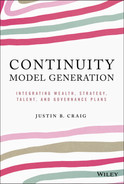Familial Meta-Framework
While there is a familial component to everything for the Continuity Model Generation, the four frameworks within the familial meta-framework make difficult conversations much easier.
The Big Tent Framework
As businesses and families evolve, promoting meaningful involvement and engagement among enterprise members presents a challenge. As one sage family business leader suggests, “entitlement and wealth become the enemy.”
Most families that have effectively addressed the challenge of engagement pursue a big tent approach. It's the idea that family leaders prefer to have the growing number of family members inside the tent, where they are provided appropriate education and other development support for meaningful roles, rather than outside the tent, where they may become suspicious of what's going on inside and even tempted to sabotage it, whether intentionally or not. Thus, a big tent approach sends a strong message, particularly to next-generation members and affines, about their potential value and contributions to the enterprise, and the importance of their involvement (Illustration 8).
But the approach requires careful, strategic orchestration.
Indeed, with an increasing number of families worldwide committed to family governance initiatives, they are in effect developing their own, idiosyncratic big tent approaches. Specifically, they are setting clear guidelines for how family members can engage meaningfully with, and contribute to, the family and its ever more complex and challenging business activities.
In lectures and presentations, when I share my observations of families who pursue the big tent approach, the metaphorical concept usually makes intuitive sense to listeners, no matter the country or audience type. But it's only when I describe what it feels like to be left out of the tent that the message really hits home.
The main example I share is when members of a founding generation explained to me that they wanted their legacy to be a family enterprise that survived across many generations. Immediately after, they stipulated that the wives of their two sons were to be excluded from all business conversations. In response, they were delicately reminded that the spouses were the mothers of their grandchildren, and therefore significant influences on how the third generation would see the business, and thus it may have made sense to “bring them into the tent”; they reconsidered and committed to establish meaningful non-operational roles for their daughters-in-law. Other, similar examples, such as those of affines who are excluded from “family” meetings, also tend to hit home.
Still, inclusion of family members for the sake of inclusion can be interpreted as a token gesture. The key, then, from my observations of insightful multigenerational family businesses, is to ensure that individuals are ready, willing, and capable to contribute in a meaningful way. I must emphasize the tripartite nature of this set of attributes, as implied by the use of the word “and” rather than “or.” That is, the omission of any one of the three qualities—such as being ready and willing but not capable—means potential disaster, or at the very least a far from ideal situation for the family and enterprise. Readiness, willingness, and capability are mandatory qualities for contribution.
This discussion also raises the question of what it means to contribute to the enterprise. Again, observation of families who spend a considerable amount of time getting this right suggests that an ideal way to promote contribution is to design meaningful pathways to contribute. There's no one right set of such pathways, but there are many examples of these types of pathways:
- Executive
- Manager/supervisor
- Enterprise/entrepreneurship
- Family office
- Family governance
- Business governance
- Family philanthropy
Each of the pathway-related roles comes with a distinct set of requirements, responsibilities, and remuneration, all of which must be clearly articulated. See again my earlier caveat that all elements of the big tent approach require careful, strategic orchestration.
So how does it all come together?
Back inside the tent, when a family member who does not work in the business understands that there are meaningful ways that they can engage with the enterprise, such as through a family office or business governance role, they are more likely to feel valued. Likewise, a married-in will feel included when they hear about opportunities for involvement in the family's philanthropic activities. Or, when a rising-generation member finds out about the enterprise pathway, they will enthusiastically consider the family business a venture partner they may need in the future to execute their own entrepreneurial vision.
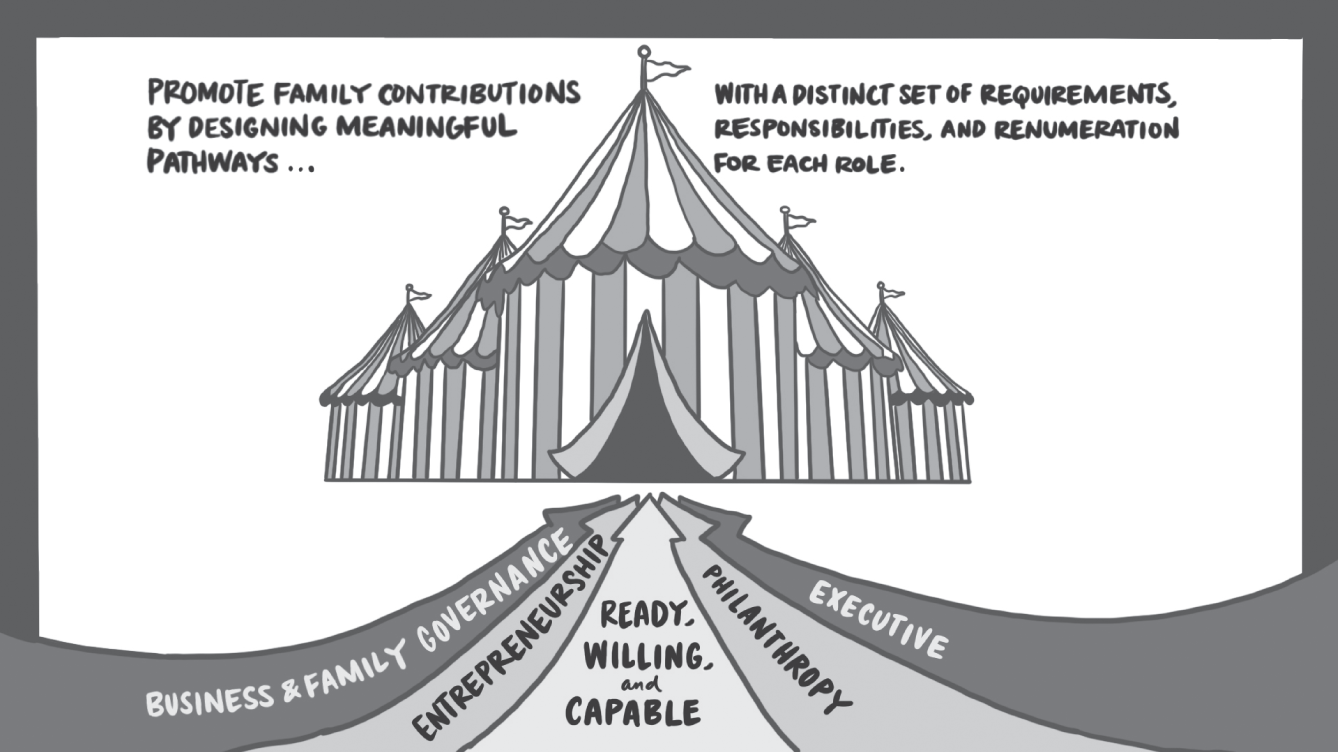
Illustration 8 THE BIG TENT APPROACH
Whatever the exact circumstance, the big tent approach helps the full range of family members to see new opportunities to contribute and to understand the need—and expectation—to have the required skill sets to deliver optimally in a given, appropriate role. That is, they recognize the importance of being ready, willing, and capable to contribute to the enterprise. This thinking is at the core of continuity modelling.
pRIPCC Best Practice Dimensions
The RIPCC framework is something I have stolen, but paraphrased, from a book written by my friend and colleague Professor Emeritus John Ward. But given the remarkable number of books and articles John has produced to help readers understand family enterprises, it's difficult for me even to know from which work I got the idea!
Ward didn't call it the RIPCC framework, but as I recall, this is what he referred to when answering a question someone posed about what he believes families who get it right actually do, based on his decades of work with business families. I've paraphrased the lessons that these families have taught him into these five dimensions.
The first dimension, the one that begins with R, is that the families respect the challenge: that is, families who get it right understand that functioning optimally in a business-owning family is challenging. The second dimension, the I, reflects that Ward believes the issues across families are the same, but the perspectives are different. What that means, I suggest, is that the issues facing business-owning families are fundamentally the same, but how they manage and navigate these issues will vary, dependent on the perspectives of individuals and family groups. The third dimension relates to planning. Ward suggests that those who get it right don't leave it to chance. They are consummate planners. This dimension, though not intentionally framed as such, is at the epicenter of the Continuity Canvas and will be clear in Part II.
The fourth dimension of the RIPCC framework concerns communication. Ward suggests families who get it right are those who find ways to communicate. Finally, and arguably the most important of the RIPCC best practice framework dimensions, concerns having a commitment: to the “us” in question.
Taking those dimensions and contextualizing them for the Continuity Model Generation, it is simple to argue that continuity will be significantly enhanced if stakeholders understand five things: (i) respect that it will be challenging; (ii) understand that the issues may be the same across families but people will have different perspectives; (iii) recognize the importance of developing plans for ownership, family, and the many entities that are being managed; (iv) see communication as vital; and (v) believe that continuity won't occur without a commitment, a significant commitment, to what the family is trying to achieve. That's the RIPCC in action (Illustration 9).
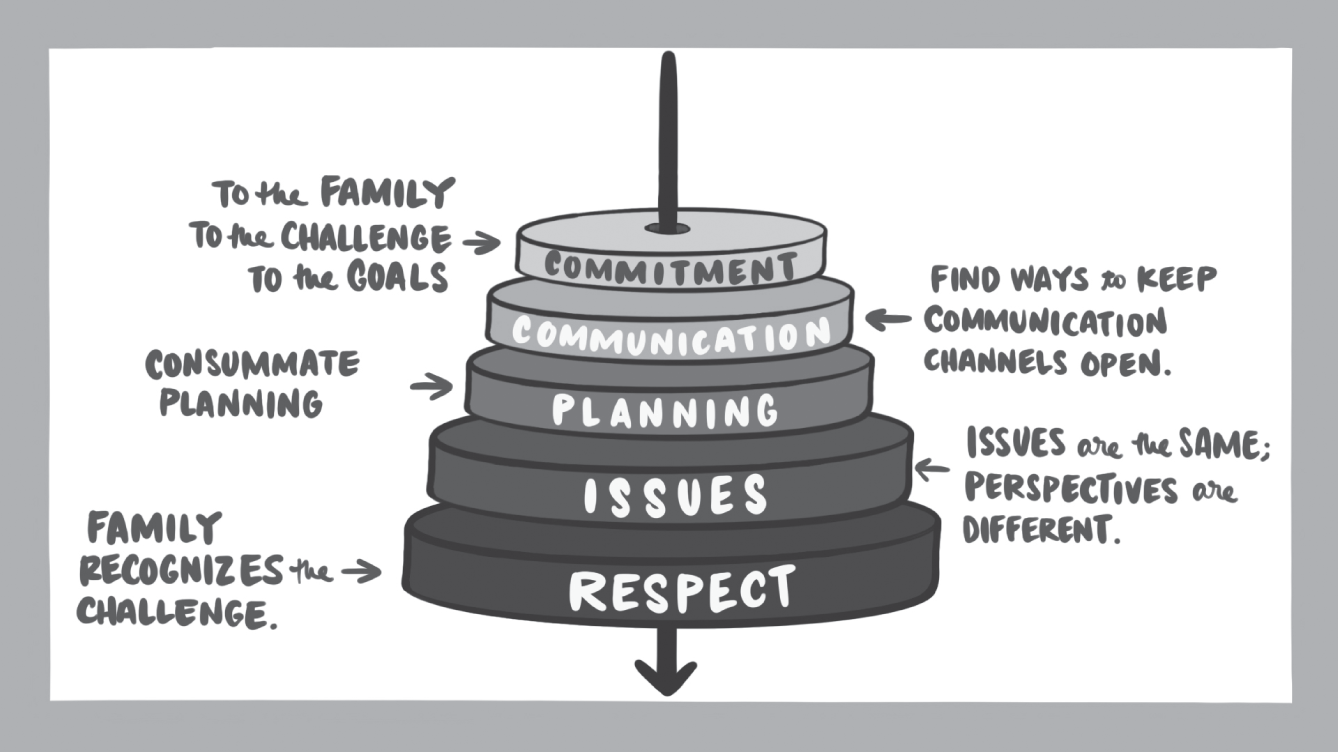
Illustration 9 RIPCC FRAMEWORK
Four Ps Framework
Related to the RIPCC framework, the four Ps framework is again unabashedly stolen and paraphrased from Ward's work. And again, I can't direct you to exactly which publication it came from, but somewhere in those volumes is a section that relates to these four dimensions. From his experience observing and working with all types of business-owning families, Ward suggests there are four critical priorities, all of which start with “p.” The first priority is parenting, and this is hard to argue against when you consider we are talking about families. The major contributors to the next generation, and this is really relevant for continuity modelling, are the parents, as reflected in the example I included in the earlier discussion of the big tent framework. Ward's recommendation here is that, to increase chances of harmony, optimal functioning, meaningful contributions, and other desirables, there needs to be a focus on being exemplary parents. The second “p” relates to familial process. My interpretation is that, too often, families get out of whack and forget to introduce ways to appreciate the fact that they are family. Most anyone involved in family business will agree that they are guilty of spending inordinate time talking about or being involved in the business, at the expense of their family. So, the second priority needs to be consciously and intentionally addressed by finding ways to include reminders that the family is a family. The third priority is one that receives immediate positive response whenever I share it: the imperative to put in place protocols before you need them. This refers especially to governance protocols and processes that set the expectations for now- and next-generation involvement, for example. The fourth priority is to develop a sense of purpose and understand the general and specific responsibilities of being part of a business-owning family (Illustration 10).
So, again, a lot of work and thinking has gone into understanding the priorities that a family should have. Parenting, familial processes, having protocols in place before they are needed, and developing a shared sense of purpose will individually and collectively contribute to addressing assumptions and be foundational in developing a continuity model mindset within the family.
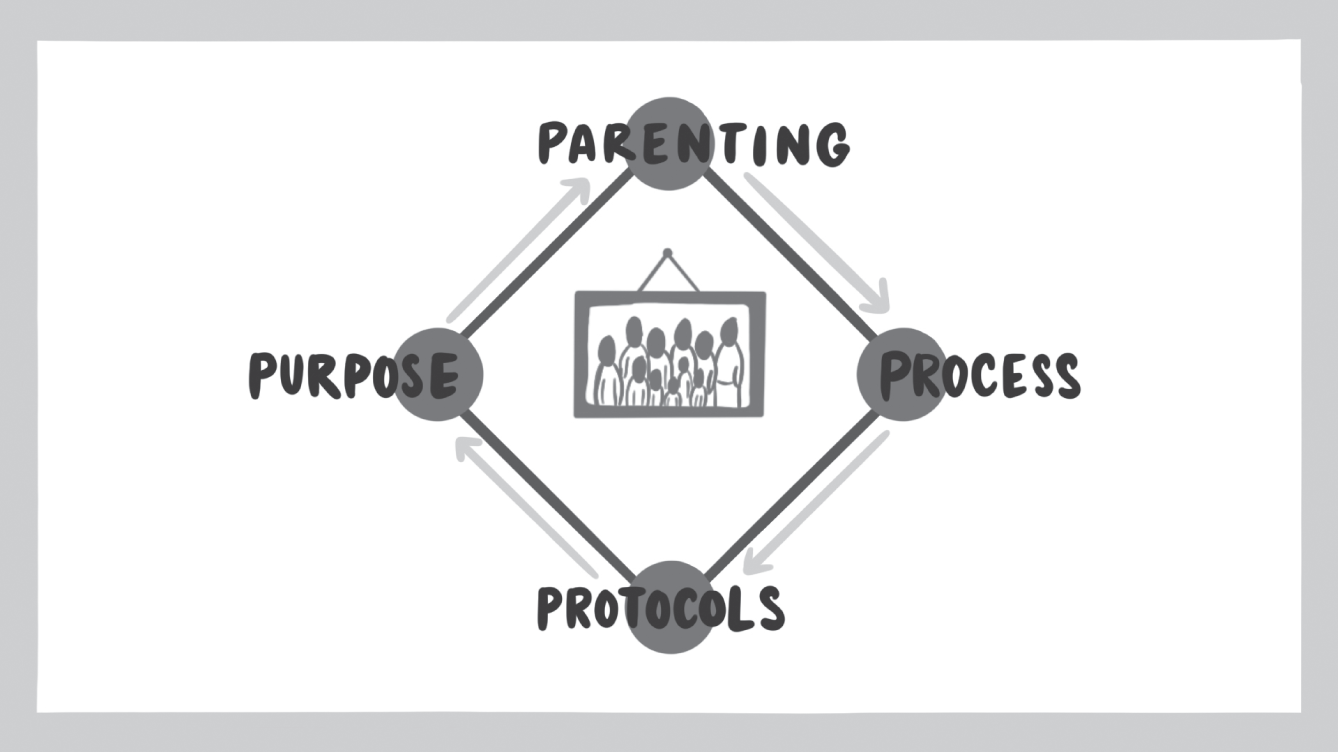
Illustration 10 THE FOUR Ps FRAMEWORK
Four Cs Framework
The fourth framework in the familial meta-framework is cut-and-pasted from the research of Professor Danny Miller and Professor Isabel LeBreton Miller. Their groundbreaking study of long-lived family-controlled businesses (FCBs) revealed that, unlike managers of most other for-profit businesses, those of FCBs seek ends in addition to profit. As such, they are more willing to make bold decisions (i.e. commands) that sacrifice some of their personal interests for the sake of their employees (i.e. community) and larger society (i.e. connections), as well as for the long-term survival of the businesses they operate (i.e. continuity).
According to the Millers, the continuity dimension is about having a focal mission and commitment to a set of related capabilities; community concerns having in place an appropriate internal employee base to formulate and implement the strategy; connection reflects that external stakeholders and resource–providers are crucial to being adaptive and being able to access scarce resources; command captures the context of governance and leadership (Illustration 11).
While the common perception of FCBs is that they are clannish, inward-thinking nests of nepotism, the exemplar firms in the Millers’ study suggest otherwise. Their owning-families foster a cohesive organizational community of employees for whom joining these FCBs is akin to joining their employer's family. The families, then, are stewards who understand that the business is a precious asset and, therefore, go to great lengths to ensure that employees who join the community appreciate the role they are tasked to play in the family heirloom's sustainability.
The Millers position community as “uniting and tending to the tribe” (2005a, p. 38). For the community, association with family owners is far more intimate than it would be in a widely held firm. Millerian families appreciate that “to cherish the firm meant to treasure those who staff and sustain it” (2005b, p. 521). As members join a community in which adhering to deeply held values rooted in the founders’ beliefs and institutionalized by subsequent generations is the principal driver—rather than bureaucratic rules or pecuniary incentives—selection processes are more comprehensive. Having a community of employees whose hearts and minds are engaged with the organization results in cohesive corporate cultures perpetuated through ongoing, intimate, trust-based relationships among community members and family owners. As a result, “stratospheric” levels of loyalty and motivation are characteristic of the cohesive internal community (2005b, p. 522). The Millers observe that building a “cohesive, gung-ho community of employees” (2005a, p. 38) contributes to a collectivist social philosophy in the outstanding FCBs in their study (e.g. the Hall family of the Hallmark Card Company). The elements of this tribal community include “strong values, not just stated, but pervasively enacted; incessant socialization in those values; a welfare state to enlist employees in the good fight; and an informal way of operating that engages interaction and collaboration” (2005a, p. 39).
Ultimately, the community of employees is charged with nurturing the “precious enterprise and strive to achieve its hallowed mission” (2005a, p. 42), by working with and on behalf of the family. They succeed together by displaying a “moral commitment to enter into an enduring relationship of broad reciprocity—like friendship or even kinship…a felt bond between employee and employer” (2005a, p. 42).
In addition to their close relationships with internal stakeholders, these FCBs are notorious for their embeddedness in their business networks. As such, they are more attuned to, cognizant of, and understanding of the need to navigate a slew of nuanced multidimensional challenges with respect to their business partners, challenges that their non-FCB contemporaries do not face. Connectivity to the broader society is considered particularly important due to an expectation and obligation to be especially generous to those that “treated them so well” (Miller and Le Breton-Miller 2005a, p. 44).
In contrast to community, the Millerian concept of connection is an externally oriented construct: “being good neighbors and partners” (2005a, p. 42). Just as concentrating on building enduring relationships with a community of employees is important, these FCBs seek similar mutually beneficial relationships with business partners, customers, and society. Being a “good neighbor and indispensable partner” (2005a, p. 42) is achieved by using “an ancient toolkit: being honest, farsighted, and generous” (2005a, p. 42). By being “meticulously honest” and delivering more than promised, “contacts grow into contracts, and contracts into age-old partnerships” (2005a, p. 43) (e.g. the Bechtel family). The Millers observe that successful FCBs favor “long-term, win-win relationships over transactions,” and because they are driven by the will for the business to last, they are willing to “put time and money into potentially sustaining associations that take a long time to pay off” (2005a, p. 43). They are, moreover, characterized as benevolent partners who build a “devoted cadre of supply chain soul mates” (2005a, p. 44). By being more responsive and committed, they form close bonds with customers and maintain them over time, often adopting a philosophy that “there is no such thing as an ex-customer” (2005a, p. 44).
In sum, the focus on prioritizing commitment both to building a community of employees passionate about adherence to the family's values-driven culture and to developing long-term, trust-based connections with loyal partners results in heightened levels of intimacy, which enables family business managers to share the feelings of and better understand their employees and business partners. In this way, families often “absorb misery” (Miller and Le Breton-Miller, 2005a, p. 40) when stakeholders face challenging situations. Consider the following events recalled by Walter Haas Jr., then-Chairman of the board of Levi Straus, in 1973 when faced with a stock-price plummet from $59.75 to $16.62:
“It was one of the worst six months of my life, very bad, not so much for the monetary loss, but for the pride. It was a reflection on our management. A big part of it was that so many little people were let down. We were terribly distressed about the stock because we had made a point of setting aside shares for our own employees when we went public. They were unsophisticated investors, and this debacle, coupled with the huge drop in the market in general.” Haas's voice faltered, the disappointment still keen, five years later.
(Cray 1978, p. 218).
The Millers define command as leaders, both those within the family and throughout the top management team, “acting independently and adapting freely” (2005a, p. 45). Their outstanding families view the freedom to act decisively and courageously as a vital source of their “competitive originality and business renewal” (2005a, p. 45). A common theme among these leaders is the ability to embrace unorthodoxy and break the rules. This ability is fortified when managers believe in one another and act for the company without the burden of worrying about termination. Yet, it is important to note that due to the managers’ responsibility for the long-run viability of the business and the reputation of the family, “boldness takes form not in gambles, but in programs of courageous, targeted adaption” (2005a, p. 48). In other words, although leaders exercising command must have “the clout, expertise, and motivation to act courageously,” those decisions must also be “in the interest of the company” (2005b, p. 525).
The knowledge of the perspectives of employees and business partners gained through intimate associations with these stakeholders provides family business leaders a platform from which they can assess how to behave with unusual boldness without disenfranchising those with whom they have created a unity of purpose. Consider the following situation and exchange involving Corning Glass Ware's non-family CEO Tom MacAvoy and family owner and Chairman Amory Houghton in 1979:
When faced with a major issue with a product line, MacAvoy remembers listening to legal advice to gather more facts and proceed deliberately before he and Houghton decided to act on the basis of simple criteria. “It gradually became apparent that our reputation, our integrity, was being questioned by some of our key people”, said MacAvoy, who found that intolerable. “If you have a dozen people who disbelieve that the company means what it says about quality and dealing with customers, its [sic] poison. So I remember I went next door and knocked on Amo's door, which happened to be closed. I opened the door, and he was there with his secretary. I said, “I've just decided we are going to recall the Corning Ware Electromatic Coffee pots.” He was dictating a letter or something like that. He said, “How much is it going to cost?” I said, “I don't know, but it's probably going to be 10 million dollars or something like that”. So, he nodded his head, and I went back and did it. It cost $14 million, but it was the right thing to do.
(Dyer and Gross 2001, p. 348).
As this example shows, the ability to sense employees’ and customers’ failing confidence in the business was the impetus for action. In the absence of a continuity mindset, MacAvoy might not have been mindful of the impact the company's product line was having on its community and connections. Yet, his awareness of their feelings toward Corning and, more importantly, the importance to Corning of maintaining intimate relationships with them, provided the rationale he needed to spearhead what ultimately became a $14-million recall, a considerable expense (especially in 1979 dollars).
In sum, families that exercise command empower their leaders to make bold decisions that, while not always in the short-term economic interest of the FCB, support its social relationships with employees and business partners.
In the Millers’ successful FCBs, the commitment to continuity through a clear intention to keep the business within the family is evident. These companies express a desire for long-term survival of the business, which results from “the relentless development of the capabilities needed to realize it” (2005a, p. 35). Continuity for these families, their companies, and the leaders at the helm in each generation means being united in their laser focus on continuing to do something better than anyone else and an understanding that achievement of this objective requires the patient investment of both financial and human resources.
In sum, the higher purpose of FCBs is to provide for future generations’ fulfillment, not only economically but socially. The essence of continuity, therefore, is devotion to a greater cause, which encompasses social and economic objectives (Tomer 2001). Thus, the contention is that family business manager–stewards who have the capacity to be courageous decision-makers and are able to strike the delicate balance between their self- and other-regarding interests will increase their chances of continuity.
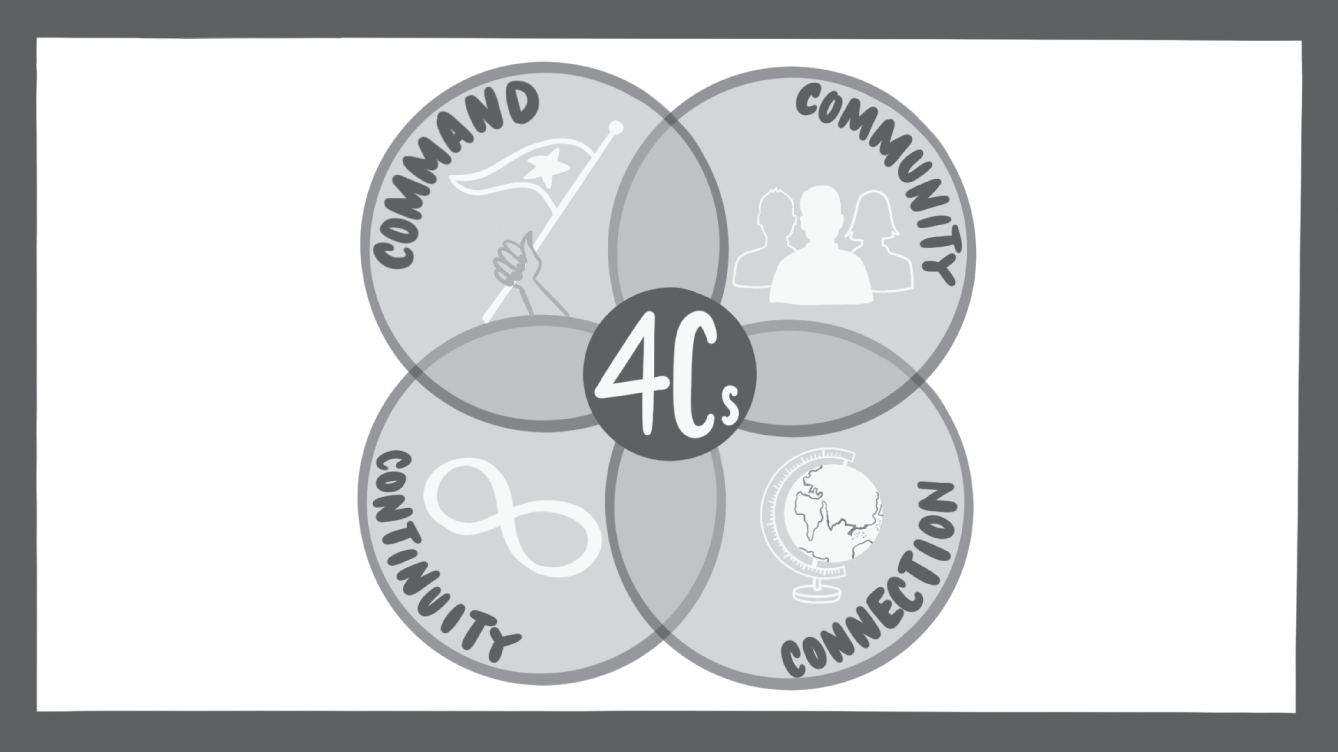
Illustration 11 THE FOUR Cs FRAMEWORK
